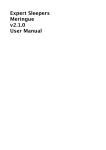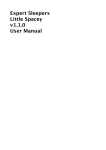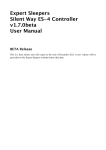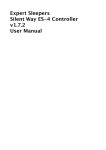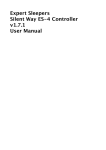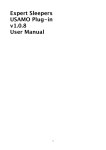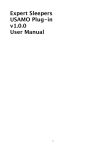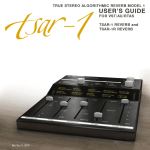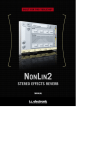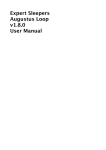Download Expert Sleepers Warbler v1.1.0 User Manual
Transcript
Expert Sleepers Warbler v1.1.0 User Manual Copyright © 2009 Expert Sleepers. All rights reserved. This manual, as well as the software described in it, is furnished under licence and may be used or copied only in accordance with the terms of such licence. The content of this manual is furnished for informational use only, is subject to change without notice, and should not be construed as a commitment by Expert Sleepers. Expert Sleepers assumes no responsibility or liability for any errors or inaccuracies that may appear in this document. THE SOFTWARE IS PROVIDED "AS IS", WITHOUT WARRANTY OF ANY KIND, EXPRESS OR IMPLIED, INCLUDING BUT NOT LIMITED TO THE WARRANTIES OF MERCHANTABILITY, FITNESS FOR A PARTICULAR PURPOSE AND NONINFRINGEMENT. IN NO EVENT SHALL THE AUTHORS OR COPYRIGHT HOLDERS BE LIABLE FOR ANY CLAIM, DAMAGES OR OTHER LIABILITY, WHETHER IN AN ACTION OF CONTRACT, TORT OR OTHERWISE, ARISING FROM, OUT OF OR IN CONNECTION WITH THE SOFTWARE OR THE USE OR OTHER DEALINGS IN THE SOFTWARE. Contents Introduction Warbler 6 6 Installation 7 Mac OS X 7 Windows 7 System Requirements 7 Mac OS X 7 Windows 7 Registration 8 Using Warbler 9 Using the controls 9 Knobs Value edit boxes 9 9 Name/value display 9 Basic usage Vibrato effects 9 9 Chorus/flange effects 10 Delay effects 10 Extreme sound mangling 10 The controls in depth 11 Speed 11 Speed LFO 11 Depth 11 Depth LFO 12 Shape 12 Chorus/Flange 13 Mix 13 Preferences 14 MIDI control 15 OSC Control 16 Reference MIDI & OSC Scripting 16 16 Reference 16 Script locations 16 Version History 17 1.1.0 14/8/2009 17 1.0.2 14/8/2007 17 1.0.1 2/8/2007 17 1.0.1 29/7/2007 17 1.0.0 27/5/2007 17 Contact 18 Acknowledgements 19 Lua 19 oscpack 19 glew 20 FreeType 21 FTGL 21 libpng 21 zlib 21 Introduction Warbler Warbler is at heart a vibrato effect, with additional controls that allow chorus/flange/ delay type effects, as well as quite unusual hybrid sounds that aren’t easily categorised. The vibrato depth ranges from subtle modulations to extreme pitch effects. The vibrato LFO (low frequency oscillator) can be set from 0Hz to 5kHz and is controlled by 3 knobs to allow accurate control over the whole range. The vibrato LFO shape can be selected from a variety of options and smoothly changed between them. The LFO speed and the vibrato depth can themselves be modulated by two extra LFOs. A ‘bias’ control is provided to change the effect from simple vibrato to something more like a traditional chorus or flange. Feedback can also be applied to give deeper, more resonant flanges or to produce echo effects. The plug-in works as a generic n-to-n processor i.e. it will do mono-to-mono, stereo-tostereo, 5-to-5 etc.. Good hosts will also allow its use as a mono-to-stereo effect (e.g. Logic does this). A ‘spread’ control is provided to offset the LFO phase per channel - giving a result much like a classic ‘stereo chorus’ effect. Installation Mac OS X Simply copy the plug-in to the appropriate folder: Library/Audio/Plug-Ins/Components for the Audio Unit version, or Library/Audio/Plug-Ins/VST for the VST version. Windows Simply copy the plug-in to your VST plug-ins folder. System Requirements Mac OS X Warbler requires at least Mac OS X version 10.2.8. Version 10.4 or higher is recommended. The plug-ins are Universal Binaries and so will work on PowerPC or Intel Macs. The Audio Unit version will work in any Audio Unit host. The VST version requires a “VST 2.4” compatible host.1 Windows Warbler has been developed and tested with Windows XP SP2. It may work with other versions of Windows (Vista included) but this is by no means guaranteed. The plug-in requires a “VST 2.4” compatible host. 1 VST is a trademark of Steinberg Media Technologies GmbH. Registration The downloadable version of Warbler stops working after 15 minutes every time you use it. To stop this happening, you need to buy a registration. You can buy a registration key online using a credit card or PayPal from the Expert Sleepers Licence Manager application. See here for more information. Note that you need at least version 1.0.6 of the Licence Manager. The e-commerce side of things is handled by eSellerate. If you have any security concerns, have a look at their website which is pretty informative. Your registration key allows you to install Warbler on up to 3 different computers (useful if for example you have a desktop computer in the studio and a laptop for live use). You need an internet connection to activate the software, though not necessarily on the computer on which you want to use it. Using Warbler Using the controls Knobs Basic use of the knobs is to click on them and drag the mouse up and down. However you can obtain different results by holding keys as follows: • • • Shift : Values change more slowly as you move the mouse. Command1 (Mac OS X)/Alt (Windows) : The knob assumes its default position. Option 2 (Mac OS X)/Control (Windows): The knob assumes integer values only. Value edit boxes These boxes (below each knob) let you enter parameter values directly. Clicking on the value highlights it in green - you can then type the desired value using the keyboard. Press enter to finish and accept the new value. While you’re typing the value, the box goes red to indicate that the value you see has not yet been accepted. Name/value display As you move the mouse around the interface, the name and current value of the control currently under the mouse is displayed in the top right of the window. This area also provides tooltips for buttons. Basic usage You’ll find audio samples demonstrating the effects below on the Expert Sleepers website. Vibrato effects When you first load Warbler, its default settings give a simple vibrato effect. The speed of the vibrato is set by the 3 speed knobs, and its depth is set by the 2 depth knobs. For normal vibrato, the range of the second speed knob (‘Fine’) and the first depth knob (‘Fine’) are most appropriate. 1 The ‘Command’ key is also known as the ‘Apple’ key - the one next to the spacebar. 2 The ‘Option’ (alt) key is the one between the Control (ctrl) key and the Command (cmd) key. The LFO type is set by the shape knob. Default is ‘sine’ - try turning it fully to the right to select ‘square’. The ‘Mix’ knobs default to 100% wet, 0% dry i.e. you only hear the effected signal. Raising the dry level will mix the two signals, resulting in a familiar ‘ensemble’ effect or thickening of the sound. Chorus/flange effects Turning the ‘Bias’ knob all the way to the right (value of 1.0) configures the plug-in as a traditional delay-line based chorus/flange effect. In this mode you’ll want to use the ‘Depth LFO’ to apply modulation. For a fuller explanation of chorus & flange, and the difference between them, I recommend these articles: http://www.harmony-central.com/Effects/Articles/Chorus/ http://www.harmony-central.com/Effects/Articles/Flanging/ It amounts to different typical delay times (20-30ms for chorus vs. 1-10ms for flange) and flange having a feedback path. Warbler offers delay times from below 1ms to more than 1s, and offers feedback, so clearly can offer a wider range of effects than is usual for a simple chorus/flange. Delay effects By raising the bias control and using the coarse depth control, with a lowish speed setting, you can select delay times more commonly associated with delay effects than with a chorus (up to over 1 second). Use the feedback control for repeating echoes. When you combine this with the depth and speed LFOs, and use bias settings that are somewhere between 0.0 and 1.0, you can get very complex effects - sort of modulated vibrato chorusy delays. Extreme sound mangling Use the coarse speed control to select audio frequency LFO modulation. You’ll also need to crank up the coarse depth control to hear an effect. Using these settings you can easily get some weird ring-modulation-like sounds, that are especially useful on drum or other nonpitched parts. The controls in depth Speed The 3 speed knobs together set the main LFO speed. Their values are simply added. The readout above the knobs shows the current speed value being used (NB this also takes into account the Speed LFO - see below). The knob ranges are • Superfine: 0-1Hz, useful for very slow modulations. • Fine: 0.5-20Hz, useful for normal vibrato effects. • Coarse: 10-5000Hz, useful for audio-rate modulation sound effects. Speed LFO The Speed LFO modulates the Speed value set above. It has simple speed and depth controls. Depth The 2 depth knobs together set the main LFO depth. Their values are simply added. The readout above the knobs shows the current depth setting currently being used (NB this also takes into account the effect of the Depth LFO - see below). Note that while the depth knobs are calibrated in percent, the depth readout shows a value in milliseconds. Also note that the depth readout value is affected by the current speed value. The reason it works this way is that the pitch modulation you hear is dependent on both the delay time (the ‘depth’ in ms) and the speed. By having the depth knob control not the delay time, but the actual pitch modulation depth, it is much easier to set a modulation amount you like and then change the speed of it. For example, if you set the depth to 100% and the LFO shape to ‘square’ you’ll hear a sound that exactly cuts out for one half of the LFO waveform. Now vary the speed, and you’ll hear the same effect just getting faster or slower, even though the depth readout shows the depth in ms varying with the speed. The above is not really important to understand - just using your ears and finding an effect you like is usually the best policy - but I mention it just to explain a little the philosophy of this control method, which might seem odd to those used to chorus/flange effects where you set the delay time in ms directly. Depth LFO The Depth LFO modulates the Depth value set above. It has simple speed and depth controls. This is most useful when bias (see below) is set to 1.0, though you can of course use it whenever you like and it will always do something to the sound. Shape The ‘Shape’ knob changes the shape of the LFO waveform. There are 5 key shapes, and the control blends between them smoothly. The shapes are • 0 - ‘Sine’, an ordinary sinusoidal waveform, useful for regular vibrato effects. • 1 - ‘Saw Up’. The pitch rises from a minimum to a maximum value then suddenly falls back to the minimum. • 2 - ‘Saw Down’. The pitch falls from a maximum to a minimum value then suddenly rises back to the maximum. • 3 - ‘Tri’, a triangle wave. Similar to ‘Sine’ but sounds slightly different. • 4 - ‘Square’, a square wave. The pitch simply alternates between two values. The ‘Spread’ knob introduces an offset in the LFO phase for each channel that the plug-in is processing. In the common case of a stereo plug-in, this amounts to altering the LFO phase of the right channel. Since the pitch of the vibrato at any point in time depends on the LFO phase, the spread control effectively introduces a pitch difference between the channels. This results in a ‘wider’ sound and/or a ‘thicker’ chorus effect (when mixed with the dry signal). Small spread values on e.g. a Sine waveform give the subtle thickening just mentioned. You can also use more extreme settings - e.g. a spread of 0.5 on a Square waveform causes the two stereo channels to ‘mirror’ each other’s pitch. Chorus/Flange The ‘Bias’ control fundamentally reconfigures the effect from being a vibrato to being a traditional modulated delay-line chorus/flange. It does this continuously however so there is a huge range of possibilities between the two extremes. When bias is set to 1.0 (i.e. it’s in chorus/flange mode) using the Depth LFO to modulate the depth often sounds good. The ‘Feedback’ knob introduces feedback into the delay line. This is commonly used in flange effects to create a more ‘resonant’ sound. Note that you can use this control regardless of the setting of bias - even when the plug-in is in pure ‘vibrato’ mode. Negative values of feedback give phase-inverted feedback in the delay line. It just sounds a bit different. Mix This section simply controls the level of the effected (‘wet’) and uneffected (‘dry’) signals. For a vibrato, you’ll probably want the dry level at zero. For a chorus, it’s usual to mix the two signals. Preferences Pressing the ‘Prefs’ button brings up a dialog where various preferences are set. These settings are shared by all instances of Warbler, and are not stored with presets. The top section shows the product version. The central section will show your serial number once you’ve bought a registration. OSC Base Port sets the base port number for OSC. See the section on OSC, below. ‘Constant redraw’ is on by default. If turned off, the GUI is only redrawn when a control changes. Use this if you’re concerned that the GUI is wasting your CPU resources. ‘Floating tooltip’ causes the parameter name and value display (usually in the top right of the GUI) to be displayed above the mouse pointer. Use this if you find it inconvenient to look away from the mouse to see the parameter value you’re altering. MIDI control All of Warbler’s parameters can be controlled via MIDI CC’s (Continuous Controllers) according to the table below. 0 2 3 4 5 8 9 11 12 13 14 15 16 17 18 19 Dry Level Effect Level Speed (superfine) Speed (fine) Speed (coarse) Depth (fine) Depth (coarse) Shape Spread Bias Feedback Speed LFO Speed Speed LFO Depth Depth LFO Speed Depth LFO Depth OSC Port Offset OSC Control Warbler can be controlled via the Open Sound Control (OSC) protocol. If you’re new to OSC, start by visiting opensoundcontrol.org. Two settings control what port the plug-in uses to listen on for OSC commands. One is the base OSC port, set in the preferences. The second is the OSC Port Offset control. If the port offset is set to something other than ‘Off’, then the two numbers are added together and the result used as the port number. E.g. if the base port is 6000 and the port offset is 1, then the plug-in will listen on port 6001. Reference All Expert Sleepers plug-ins that support OSC share a common implementation. This is documented in the ‘OSC Control Manual’, available from the Expert Sleepers website. MIDI & OSC Scripting It is possible to extend the plug-in’s MIDI & OSC functionality via user-writeable scripts. Indeed, the standard MIDI functionality described above has been re-implemented using such a script, which you can use as reference for your customisations. The language used for the MIDI scripts is Lua. You will find a complete description of the language, and some useful tutorials, at the Lua website: www.lua.org All the standard language features of Lua are available in the scripts, plus some extra functions specific to the Expert Sleepers system. Reference All Expert Sleepers plug-ins that support MIDI/OSC scripting share a common implementation. This is documented in a the ‘MIDI & OSC Scripting Manual’, available from the Expert Sleepers website. Script locations The plug-in name for constructing the script locations is ‘Warbler’. Version History 1.1.0 14/8/2009 • • • Added MIDI and OSC control and scripting. Added text value displays under the knobs in the GUI. Added factory presets. 1.0.2 14/8/2007 • Fixed a bug in the Windows version’s handling of font files, which could cause a crash on some systems when opening the GUI. 1.0.1 2/8/2007 • First Windows version. 1.0.1 29/7/2007 • (VST only) Fixed compatibility issue with FXpansion’s VST wrappers on Intel Macs. 1.0.0 27/5/2007 • First release. Contact The Expert Sleepers website is here: http://www.expert-sleepers.co.uk/ Or you can email [email protected] Or you can use the forum, which is here: http://www.kvraudio.com/forum/viewforum.php?f=85 Acknowledgements The software described in this manual makes use of the following open source projects. The author is greatly indebted to them for their efforts and generosity. Below are reproduced the various copyright notices and disclaimers that accompany these software projects, in accordance with their terms of use. Lua Copyright (C) 1994-2008 Lua.org, PUC-Rio. Permission is hereby granted, free of charge, to any person obtaining a copy of this software and associated documentation files (the "Software"), to deal in the Software without restriction, including without limitation the rights to use, copy, modify, merge, publish, distribute, sublicense, and/or sell copies of the Software, and to permit persons to whom the Software is furnished to do so, subject to the following conditions: The above copyright notice and this permission notice shall be included in all copies or substantial portions of the Software. THE SOFTWARE IS PROVIDED "AS IS", WITHOUT WARRANTY OF ANY KIND, EXPRESS OR IMPLIED, INCLUDING BUT NOT LIMITED TO THE WARRANTIES OF MERCHANTABILITY, FITNESS FOR A PARTICULAR PURPOSE AND NONINFRINGEMENT. IN NO EVENT SHALL THE AUTHORS OR COPYRIGHT HOLDERS BE LIABLE FOR ANY CLAIM, DAMAGES OR OTHER LIABILITY, WHETHER IN AN ACTION OF CONTRACT, TORT OR OTHERWISE, ARISING FROM, OUT OF OR IN CONNECTION WITH THE SOFTWARE OR THE USE OR OTHER DEALINGS IN THE SOFTWARE. oscpack oscpack -- Open Sound Control packet manipulation library http://www.audiomulch.com/~rossb/code/oscpack Copyright (c) 2004 Ross Bencina <[email protected]> Permission is hereby granted, free of charge, to any person obtaining a copy of this software and associated documentation files (the "Software"), to deal in the Software without restriction, including without limitation the rights to use, copy, modify, merge, publish, distribute, sublicense, and/or sell copies of the Software, and to permit persons to whom the Software is furnished to do so, subject to the following conditions: The above copyright notice and this permission notice shall be included in all copies or substantial portions of the Software. Any person wishing to distribute modifications to the Software is requested to send the modifications to the original developer so that they can be incorporated into the canonical version. THE SOFTWARE IS PROVIDED "AS IS", WITHOUT WARRANTY OF ANY KIND, EXPRESS OR IMPLIED, INCLUDING BUT NOT LIMITED TO THE WARRANTIES OF MERCHANTABILITY, FITNESS FOR A PARTICULAR PURPOSE AND NONINFRINGEMENT. IN NO EVENT SHALL THE AUTHORS OR COPYRIGHT HOLDERS BE LIABLE FOR ANY CLAIM, DAMAGES OR OTHER LIABILITY, WHETHER IN AN ACTION OF CONTRACT, TORT OR OTHERWISE, ARISING FROM, OUT OF OR IN CONNECTION WITH THE SOFTWARE OR THE USE OR OTHER DEALINGS IN THE SOFTWARE. glew The OpenGL Extension Wrangler Library Copyright (C) 2002-2007, Milan Ikits <milan ikits[]ieee org> Copyright (C) 2002-2007, Marcelo E. Magallon <mmagallo[]debian org> Copyright (C) 2002, Lev Povalahev All rights reserved. Redistribution and use in source and binary forms, with or without modification, are permitted provided that the following conditions are met: * Redistributions of source code must retain the above copyright notice, this list of conditions and the following disclaimer. * Redistributions in binary form must reproduce the above copyright notice, this list of conditions and the following disclaimer in the documentation and/or other materials provided with the distribution. * The name of the author may be used to endorse or promote products derived from this software without specific prior written permission. THIS SOFTWARE IS PROVIDED BY THE COPYRIGHT HOLDERS AND CONTRIBUTORS "AS IS" AND ANY EXPRESS OR IMPLIED WARRANTIES, INCLUDING, BUT NOT LIMITED TO, THE IMPLIED WARRANTIES OF MERCHANTABILITY AND FITNESS FOR A PARTICULAR PURPOSE ARE DISCLAIMED. IN NO EVENT SHALL THE COPYRIGHT OWNER OR CONTRIBUTORS BE LIABLE FOR ANY DIRECT, INDIRECT, INCIDENTAL, SPECIAL, EXEMPLARY, OR CONSEQUENTIAL DAMAGES (INCLUDING, BUT NOT LIMITED TO, PROCUREMENT OF SUBSTITUTE GOODS OR SERVICES; LOSS OF USE, DATA, OR PROFITS; OR BUSINESS INTERRUPTION) HOWEVER CAUSED AND ON ANY THEORY OF LIABILITY, WHETHER IN CONTRACT, STRICT LIABILITY, OR TORT (INCLUDING NEGLIGENCE OR OTHERWISE) ARISING IN ANY WAY OUT OF THE USE OF THIS SOFTWARE, EVEN IF ADVISED OF THE POSSIBILITY OF SUCH DAMAGE. Mesa 3-D graphics library Version: 7.0 Copyright (C) 1999-2007 Brian Paul All Rights Reserved. Permission is hereby granted, free of charge, to any person obtaining a copy of this software and associated documentation files (the "Software"), to deal in the Software without restriction, including without limitation the rights to use, copy, modify, merge, publish, distribute, sublicense, and/or sell copies of the Software, and to permit persons to whom the Software is furnished to do so, subject to the following conditions: The above copyright notice and this permission notice shall be included in all copies or substantial portions of the Software. THE SOFTWARE IS PROVIDED "AS IS", WITHOUT WARRANTY OF ANY KIND, EXPRESS OR IMPLIED, INCLUDING BUT NOT LIMITED TO THE WARRANTIES OF MERCHANTABILITY, FITNESS FOR A PARTICULAR PURPOSE AND NONINFRINGEMENT. IN NO EVENT SHALL BRIAN PAUL BE LIABLE FOR ANY CLAIM, DAMAGES OR OTHER LIABILITY, WHETHER IN AN ACTION OF CONTRACT, TORT OR OTHERWISE, ARISING FROM, OUT OF OR IN CONNECTION WITH THE SOFTWARE OR THE USE OR OTHER DEALINGS IN THE SOFTWARE. Copyright (c) 2007 The Khronos Group Inc. Permission is hereby granted, free of charge, to any person obtaining a copy of this software and/or associated documentation files (the "Materials"), to deal in the Materials without restriction, including without limitation the rights to use, copy, modify, merge, publish, distribute, sublicense, and/or sell copies of the Materials, and to permit persons to whom the Materials are furnished to do so, subject to the following conditions: The above copyright notice and this permission notice shall be included in all copies or substantial portions of the Materials. THE MATERIALS ARE PROVIDED "AS IS", WITHOUT WARRANTY OF ANY KIND, EXPRESS OR IMPLIED, INCLUDING BUT NOT LIMITED TO THE WARRANTIES OF MERCHANTABILITY, FITNESS FOR A PARTICULAR PURPOSE AND NONINFRINGEMENT. IN NO EVENT SHALL THE AUTHORS OR COPYRIGHT HOLDERS BE LIABLE FOR ANY CLAIM, DAMAGES OR OTHER LIABILITY, WHETHER IN AN ACTION OF CONTRACT, TORT OR OTHERWISE, ARISING FROM, OUT OF OR IN CONNECTION WITH THE MATERIALS OR THE USE OR OTHER DEALINGS IN THE MATERIALS. FreeType The FreeType Project is copyright (C) 1996-2000 by David Turner, Robert Wilhelm, and Werner Lemberg. THE FREETYPE PROJECT IS PROVIDED `AS IS' WITHOUT WARRANTY OF ANY KIND, EITHER EXPRESS OR IMPLIED, INCLUDING, BUT NOT LIMITED TO, WARRANTIES OF MERCHANTABILITY AND FITNESS FOR A PARTICULAR PURPOSE. IN NO EVENT WILL ANY OF THE AUTHORS OR COPYRIGHT HOLDERS BE LIABLE FOR ANY DAMAGES CAUSED BY THE USE OR THE INABILITY TO USE, OF THE FREETYPE PROJECT. FTGL Copyright (C) 2001-3 Henry Maddocks Permission is hereby granted, free of charge, to any person obtaining a copy of this software and associated documentation files (the "Software"), to deal in the Software without restriction, including without limitation the rights to use, copy, modify, merge, publish, distribute, sublicense, and/or sell copies of the Software, and to permit persons to whom the Software is furnished to do so, subject to the following conditions: The above copyright notice and this permission notice shall be included in all copies or substantial portions of the Software. THE SOFTWARE IS PROVIDED "AS IS", WITHOUT WARRANTY OF ANY KIND, EXPRESS OR IMPLIED, INCLUDING BUT NOT LIMITED TO THE WARRANTIES OF MERCHANTABILITY, FITNESS FOR A PARTICULAR PURPOSE AND NONINFRINGEMENT. IN NO EVENT SHALL THE AUTHORS OR COPYRIGHT HOLDERS BE LIABLE FOR ANY CLAIM, DAMAGES OR OTHER LIABILITY, WHETHER IN AN ACTION OF CONTRACT, TORT OR OTHERWISE, ARISING FROM, OUT OF OR IN CONNECTION WITH THE SOFTWARE OR THE USE OR OTHER DEALINGS IN THE SOFTWARE. libpng http://www.libpng.org/pub/png/libpng.html zlib http://www.zlib.net/





















